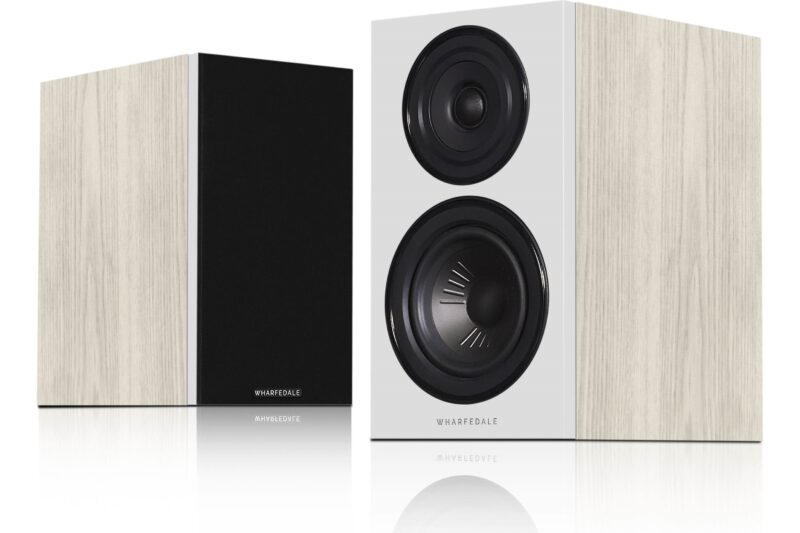Wharfedale is back with yet another impressive Diamond bookshelf speaker!
Wharfedale’s Diamond speaker has been a cornerstone of their product line for almost forty years, basically ushering in the popularity of inexpensive 2-way bookshelf speakers. Because of this line, it became en vogue for hi-fi enthusiasts to start their journey with affordable yet capable mini-monitors instead of huge boxes with large woofers.
I personally used a pair of Wharfedale Diamond 7 bookshelf speakers (complete with funky-looking plastic baffles) in one of my first systems, connecting them to a Denon stereo receiver I won as a sales award. I then moved them on to my first integrated amp, a Cambridge Audio Azur.
Back then, I loved their wide soundstage, vivid imaging, and decent bass for their size; basically the same characteristics I look for in a pair of standmount speakers today.
Now twenty-something years later, I’m listening to Wharfedale’s Diamond 12.2 Bookshelf Speaker ($499 as tested), a boxy 2-way model just like the original Diamond. Unlike the original Diamond, which was a single model, the new one is part of a series, taking its place as the larger bookshelf in the line. It’s also a lot prettier to look at.
This latest Diamond standmount is a complete redesign. That means it’s a total departure in both looks and sound from the previous model. While the Diamond 11 with its curved enclosure trended toward smoothness and warmth, the Diamond 12 with its box enclosure now moves toward greater precision and enhanced dynamics. As such, it has a faster, more agile sound.
The Diamond 12.2’s fast, tight bass, focused imaging, and detailed highs provide a vibrant soundscape that is definitely worth a listen. Especially if you like a speaker with impeccable timing and dynamics. Read on for more details regarding this spellbinding affordable speaker!
Disclaimer: The Diamond 12.2 was sent over as a review loan by the US distributor; it will be returned upon completion of this review.
Build/Features
The 2-way Diamond 12.2 features a brand new 6-1/2″ Klarity™ woofer made of polypropylene augmented with mica for additional stiffness. The stiffness of the cone is further augmented by ribs molded into its surface. This is said to contribute to extended yet tight bass, plus reduce coloration and supply speed to the performance.
This Klarity woofer is mated to a new 1” woven polyester dome tweeter, which is pretty much par for the course for this type of speaker. According to Wharfedale, the tweeter’s flat front plate and magnet system allow for wide dispersion, providing a wide sweet spot and filling the room with sound.
As far as the enclosure is concerned, as stated earlier, Wharfedale has moved away from the curved cabinet/ bottom slot-port design of the Diamond 11. This time around, they are using a more traditional rear-ported (bass reflex) box, a choice that seems to result from the hiring of prolific speaker designer Karl-Heinz Fink.
Fink, the man behind several well-received loudspeakers like the Q Acoustics 3020i and Concept 300 (check out our reviews here and here), was recruited to guide the development of the Diamond 12 line. He is known for his use of computer modeling to eliminate cabinet vibrations while keeping costs low, and he has applied that expertise to the Diamond 12 series.
The Diamond 12.2’s enclosure has a multi-layered sandwich design to quell resonance. There is also what Wharfedale calls “Intelligent Spot Bracing,” which uses the aforementioned computer modeling to pick the precise placement of the internal wood braces.
This sounds a lot like the P2P bracing in the Q Acoustics 3020i, which worked well to optimize cabinet vibration reduction, thus cleaning up the midrange.
The Diamond 12.2 is a compact yet substantial speaker, and you can feel the work put into cabinet reinforcement upon picking it up. I didn’t expect them to be as heavy as they are. A quick rap test also bears witness to the enclosure’s stoutness, as I only got a brief “thunk” upon tapping them.
On the rear of each speaker are dual five-way binding posts, which allow for bi-wiring and bi-amping, a feature that returns to the Diamond speaker after its removal from the Diamond 11 standmount models.
I always marveled at a speaker at this price range, including this option, since I don’t see too many people doing bi-amping with an entry-level bookshelf. However, this gives the impression of a speaker looking to “punch above its weight,” as they say.
As far as looks go, I really dig the aesthetic of the Light Oak model the company sent out. It gives me Scandinavian vibes a la Dali speakers, except here, Wharfedale ups the ante with a glossy white baffle and tasteful chrome accents. Magnetic grilles complete the clean look. I’m a fan!
Specs
- 1″ soft dome tweeter (woven polyester)
- 6-1/2″ Klarity™ woofer (polypropylene and mica)
- bass-reflex design (rear port)
- frequency response: 50-20,000 Hz (±3dB)
- sensitivity: 88 dB
- nominal impedance: 8 ohms
- minimum impedance 4 ohms
- recommended amplifier power: 20-120 watts
- dual five-way binding post speaker terminals allow bi-wiring and bi-amping
- removable grilles
- 7-7/8″W x 13-1/4″H x 12-3/8″D
- weight: 18.1 lbs. Each
Listening To The Wharfedale Diamond 12.2
For testing purposes, I used the $1299 Audiolab 6000A Play Integrated Amp and its built-in Play-Fi streamer along with the excellent $549 Audiolab 6000CDT CD Transport. I love this neutral, high-current setup because it really lets me know what the speakers are doing.
With its rated sensitivity of 88db, I found Diamond 12.2 speaker is a relatively easy speaker to drive, even though I would still recommend a high-current amp to handle its impedance drops (which can go as low as 4 ohms). The 6000A Play is fully capable of handling 4-ohm loads, but be careful with inexpensive AVRs and Stereo Receivers.
I set them up on metal stands about two and a half feet from the wall behind them and about three feet from the side walls. They sat about 9 feet from the listening position and benefited from a slight toe-in pointed almost directly at the listener.
I usually place speakers out further into the room, about three feet from the back wall, but the added proximity to the rear boundary added some nice bass weight.
Upon my first listen, I was very impressed at how balanced and composed the Diamond 12.2 were for the price. The only other speaker in this price range that comes close (to me) is the Triangle Borea BR03, which I don’t remember being as revealing or transparent.
These speakers are very crisp and reserved, providing nice detail on the top end, along with an accurate midrange and speedy, taut bass that drives the music in a beautifully dynamic way.
Because of that, I really liked this speaker with classic rock, especially on Fleetwood Mac’s “Go Your Own Way” (listen with Free 30 Day Amazon Music HD Trial) when they really drove the groove home and got my head nodding. The drums hit with authority and preciseness you don’t usually hear in a $500 speaker.
The other thing that I liked about these speakers was their remarkable focus. Images just snapped into place with clearly defined edges. The soundstage wasn’t all that wide, but it was quite deep and tall, giving you the 3D effect you would expect from speakers that cost twice the price. I would say they are class-leading in this regard.
I listened to Miles Davis’ “Miles Ahead” (listen with Free 30 Day Amazon Music HD Trial) album, and the instrument separation and layering floored me. You could clearly hear the complete orchestra stretched across the soundstage, and each instrument was placed impeccably.
On “The Maids Of Cadiz,” the song starts with a Miles Davis solo in the left speaker, and I was amazed at how he jumped out of the speaker. It was beautiful.
Despite its technical prowess, I did have an issue with the Diamond 12.2. Basically, I found it to be a little cold for my personal taste at times. It didn’t quite have the warmth and richness I loved in the Diamond 11.2 speaker.
Because of this, it was just a little too straightlaced at points and lacked a little bit of the soul present in the former Diamond. Vocals and horns seemed just a touch flat at times. Would a tube amp add some needed warmth? Possibly. Unfortunately, I didn’t have one on hand.
That said, the Diamond 12.2 blows the older model out in overall refinement, tonal balance, depth of bass, transparency, soundstage, and imaging. It’s probably the best overall technical performer I’ve heard at this price point (under $500).
The Wrap Up
The Wharfedale Diamond 12.2 is a beautiful, well-constructed speaker that clearly demonstrates how far this market segment has come. It sets a new standard for build quality at this price range. Soundwise, it does things unimaginable at this price even a year ago.
The soundstage and imaging are class-leading, plus the bass is fast, deep, and precise. I personally could use just a touch more warmth and richness in the upper bass and low mids, but I haven’t heard another speaker at this price range with such precise separation and placement.
If you like a neutral, refined, speaker that can still get down with the best of them, you need to give the Diamond 12.2 a listen.

I’m an audio writer who started as a young audio salesman/consumer electronics professional back in the late 90s. That’s where I discovered the magic of 2-Channel sound. My hunger for great sound has led me on a delightful music quest that continues today.









Leave a Reply